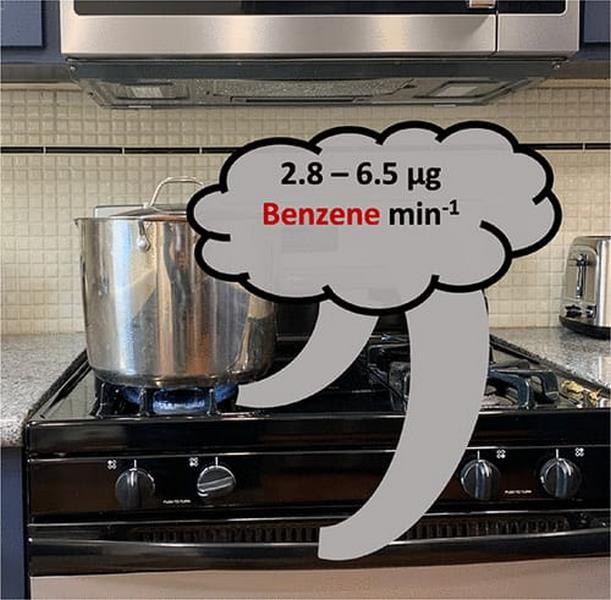Turning on gas stoves puts your health at danger, according to a study. Gas stoves release higher levels of cancer-causing chemical benzene than secondhand smoke. According to the researchers, benzene exposure causes both cancer and noncancerous health problems.
The researchers discovered that benzene levels in houses with gas stoves can exceed those observed in secondhand smoke. They also discovered that benzene does not stay in the kitchen; it spreads throughout the house, and levels observed in bedrooms frequently surpassed safe levels.
Unfortunately, even when vented directly outside, oven exhaust hoods were ineffective at eliminating benzene from the houses.

“Shorter-term benzene exposure suppresses blood cell production, and chronic benzene exposure increases the risk of leukemias and lymphomas,” the research said.
“The carcinogenic effects of benzene exposure follow a linear dose-response curve with no lower threshold, meaning that any additional benzene exposure increases leukemia and lymphoma risk.”
A gas stove is a type of cooking device that runs on natural gas, propane, butane, liquefied petroleum gas, or other flammable gas. They have been a kitchen mainstay for many years due to their dependability, perfect temperature control, and instant reactivity.
Benzene levels in 87 homes
The study, which evaluated benzene levels in 87 homes in California and Colorado, discovered that gas and propane stoves commonly released benzene at levels far beyond the World Health Organization and the US Environmental Protection Agency (EPA) healthy standards.
The study titled, “Gas and Propane Combustion from Stoves Emits Benzene and Increases Indoor Air Pollution”, led by scientists at Stanford University published on Environmental Science and Technology, is the first to quantify combustion-based benzene emission factors from gas and propane stoves.
The researchers investigated benzene emissions from various types of stoves (electric coil, radiant, and induction).
“To isolate benzene emissions from fuel use from any emissions from cooking food, we quantified benzene emissions from all cooktop elements by boiling water using the same pot in all homes and by measuring emissions in empty ovens. Beyond the fuel, another potential source of benzene associated with cooking is the food, particularly emissions from heating fats and oils.
“Maximum recommended frying temperatures are approx. 190 °C, and previous research suggested that common frying oils produce not more than 2.5 ng benzene per g oil per minute at 200 °C. We tested whether food itself is a source of benzene by cooking two meal types using nonbenzene-emitting induction cooktops.”
Earlier studies led by Stanford shed light on how gas-burning stoves inside U.S. homes leak methane, with a climate impact equivalent to the carbon dioxide emissions from about 500,000 gasoline-powered cars.
They also expose users to contaminants like nitrogen dioxide, which can lead to respiratory problems.
According to a 2013 meta-analysis, children living in houses with gas stoves had a 42% higher risk of asthma than those living in homes without gas stoves. A 2022 study also linked gas stoves to 12.7% of childhood asthma cases in the United States.
Chronic Exposure to Benzene
Benzene is a colorless, sweet-smelling, extremely combustible chemical molecule. It is a large component of crude oil and thus a key component in gasoline. It is a starting material in the production of several chemicals, including plastics, resins, synthetic fibers, rubber, dyes, detergents, pharmaceuticals, and pesticides.
People can be exposed to benzene in the environment through gasoline fumes, automotive exhaust, factory emissions, and waste water from certain industries. It is also present in tobacco smoke.
Chronic benzene exposure mostly damages the bone marrow, the location of new blood cell formation, which can lead to a decrease in red blood cells, resulting in anemia. It can also induce excessive bleeding and weaken the immune system, raising the risk of infection.
Several health organizations, including the International Agency for Research on Cancer and the United States National Toxicology Program, have categorized benzene as a carcinogen. It has been associated to leukemia and other blood cell cancers.
When benzene gets released into the environment, it combines with other compounds and breaks down within a few days. Its breakdown products can be deposited by rain, but the majority of them end up in the soil or surface water and can enter the soil through the air or water.
Environmental Impacts on Natural Gas
The initial cost of a gas stove may be higher, but the cost of natural gas or propane is typically lower than that of electricity, making it more cost-effective.
Although natural gas is frequently promoted as a clean energy source, it does contribute to greenhouse gas emissions by emitting carbon dioxide.
Methane, a main component of natural gas and a potent greenhouse gas, can escape during natural gas production and transportation.
A recent study found that gas stoves can leak small amounts of methane even when turned off; these leaks, spread across millions of burners, might have the same global impact as 500,000 gasoline-powered cars emitting carbon dioxide.
Way forward
To decrease exposure to pollutants from gas stoves, the researchers recommend appropriate ventilation, such as using a range hood or keeping a window open.
Furthermore, cost-effective methods can be implemented. Using portable induction cooktops is one such idea.
Tea kettles, toaster ovens, and slow cookers are among recommended electric kitchen appliance.


